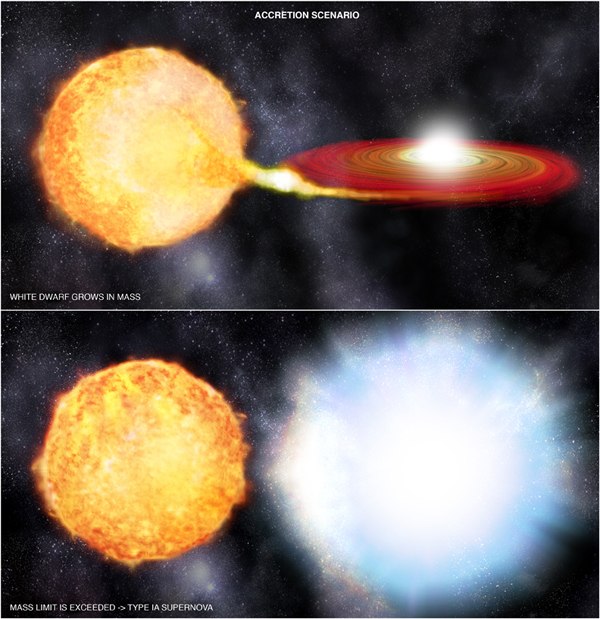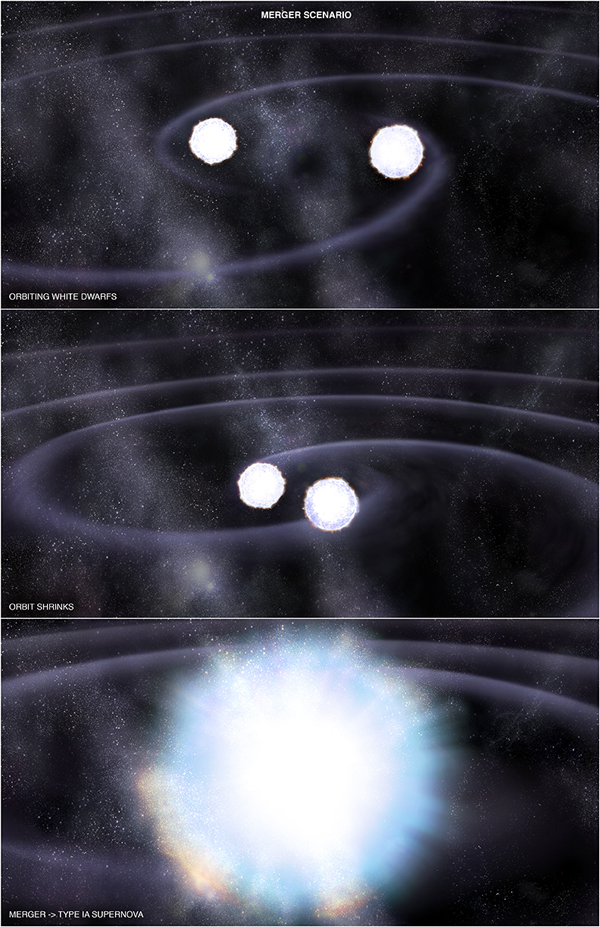Type Ia supernovae stem from the explosion of white dwarfs coupled with twin stars
Study discards possibility that type Ia supernovae might stem from explosions of white dwarfs nourished by normal stars. Were these conclusions to become generalized, type Ia supernovae might no longer serve as “standard candles” to measure astronomical distances
Type Ia supernovae happen when a white dwarf, the “corpse” of a star similar to the Sun, absorbs material from a twin star until it reaches a critical mass--1.4 times that of the Sun—and explodes. Because of their origin, all these explosions share a very similar luminosity. This uniformity made type Ia supernovae ideal objects to measure distances in the universe, but the study of supernova 2014J suggests that there could be different paths leading to a type Ia supernova explosion.
"These different paths may lead to intrinsically large variations in brightness. Until now astronomers have empirically corrected this spread in brightness, which has allowed us to discover that the universe was expanding at an accelerating rate. However, to do precision cosmology, we probably need to identify the origin of each individual type Ia explosion. We have yet not reached that level of understanding”, says Miguel Ángel Pérez Torres, researcher at the Institute of Astrophysics of Andalusia (IAA-CSIC) in charge of the study.

A new model postulating the fusion of two white dwarfs is now challenging the predominant one, consisting of a white dwarf and a normal star. The new scenario does not imply the existence of a maximum mass limit and will not, therefore, necessarily produce explosions of similar luminosity.
SN 2014J, A SUPERNOVA VERY NEAR BY

The results mentioned above were obtained from the study of supernova 2014J, situated 11.4 million light years away from our planet, using the EVN and eMERLIN networks of radio telescopes. “It is a phenomenon that very seldom occurs in our immediate universe. 2014J has been the Ia type supernova closest to us since 1986, when the telescopes were much less sensitive, and it may well be the only one we’ll be able to observe in such vicinity in the next one hundred and fifty years,” says Pérez Torres (IAA-CSIC).
Radio observation makes it possible to reveal what stellar systems lie behind type Ia supernovae. If the explosion proceeds from a white dwarf being nourished by a twin star, for example, a great amount of gas should be present in the environment; after the explosion, the material ejected by the supernova will collide with this gas and produce an intense emission of X rays and radio waves. By contrast, a couple of white dwarfs will not generate this gaseous envelope and, therefore, there will be no emission of either X rays or radio waves.
"We have not detected radio emissions on SN 2014J, which favours the second scenario", says Pérez Torres. "If these results were to gain general acceptance, the cosmological consequences would be weighty, because the use of type Ia supernovae to measure distances would come into question,” the researcher concludes.
Fuente imágenes: NASA/CXC/M Weiss
M. A. Perez-Torres, P. Lundqvist, R. J. Beswick, C. I. Bjornsson, T. W. B. Muxlow, Z. Paragi, S. Ryder, A. Alberdi, C. Fransson, J. M. Marcaide, I. Marti-Vidal, E. Ros, M. K. Argo, J. C. Guirado. Constraints on the progenitor system and the environs of SN 2014J from deep radio observations. The Astrophysical Journal. ApJ, vol. 792, pág. 38.
Instituto de Astrofísica de Andalucía (IAA-CSIC)
Unidad de Divulgación y Comunicación
Silbia López de Lacalle - sll[arroba]iaa.es - 958230532
http://www.iaa.es
http://divulgacion.iaa.es

